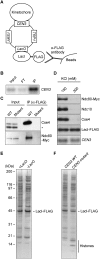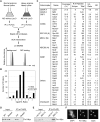Quantitative proteomic analysis of purified yeast kinetochores identifies a PP1 regulatory subunit
- PMID: 19948764
- PMCID: PMC2800092
- DOI: 10.1101/gad.1865909
Quantitative proteomic analysis of purified yeast kinetochores identifies a PP1 regulatory subunit
Erratum in
-
Corrigendum: Quantitative proteomic analysis of purified yeast kinetochores identifies a PP1 regulatory subunit.Genes Dev. 2016 Oct 15;30(20):2339. doi: 10.1101/gad.291450.116. Genes Dev. 2016. PMID: 27898395 Free PMC article. No abstract available.
Abstract
The kinetochore is a macromolecular complex that controls chromosome segregation and cell cycle progression. When sister kinetochores make bioriented attachments to microtubules from opposite poles, the spindle checkpoint is silenced. Biorientation and the spindle checkpoint are regulated by a balance between the Ipl1/Aurora B protein kinase and the opposing activity of protein phosphatase I (PP1). However, little is known about the regulation of PP1 localization and activity at the kinetochore. Here, we developed a method to purify centromere-bound kinetochores and used quantitative proteomics to identify the Fin1 protein as a PP1 regulatory subunit. The Fin1/PP1 complex is regulated by phosphorylation and 14-3-3 protein binding. When Fin1 is mislocalized, bipolar spindles fail to assemble but the spindle checkpoint is inappropriately silenced due to PP1 activity. These data suggest that Fin1 is a PP1 regulatory subunit whose spatial and temporal activity must be precisely controlled to ensure genomic stability.
Figures







Comment in
-
Overcoming inhibition in the spindle checkpoint.Genes Dev. 2009 Dec 15;23(24):2799-805. doi: 10.1101/gad.1882109. Genes Dev. 2009. PMID: 20008930 Free PMC article. Review.
Similar articles
-
Yeast Fin1-PP1 dephosphorylates an Ipl1 substrate, Ndc80, to remove Bub1-Bub3 checkpoint proteins from the kinetochore during anaphase.PLoS Genet. 2021 May 25;17(5):e1009592. doi: 10.1371/journal.pgen.1009592. eCollection 2021 May. PLoS Genet. 2021. PMID: 34033659 Free PMC article.
-
Phosphoregulation of Spc105 by Mps1 and PP1 regulates Bub1 localization to kinetochores.Curr Biol. 2012 May 22;22(10):900-6. doi: 10.1016/j.cub.2012.03.052. Epub 2012 Apr 19. Curr Biol. 2012. PMID: 22521787 Free PMC article.
-
Fin1-PP1 Helps Clear Spindle Assembly Checkpoint Protein Bub1 from Kinetochores in Anaphase.Cell Rep. 2016 Feb 9;14(5):1074-1085. doi: 10.1016/j.celrep.2016.01.007. Epub 2016 Jan 28. Cell Rep. 2016. PMID: 26832405 Free PMC article.
-
Spindle checkpoint silencing: PP1 tips the balance.Curr Biol. 2011 Nov 8;21(21):R898-903. doi: 10.1016/j.cub.2011.08.063. Curr Biol. 2011. PMID: 22075433 Review.
-
The Opposing Functions of Protein Kinases and Phosphatases in Chromosome Bipolar Attachment.Int J Mol Sci. 2019 Dec 7;20(24):6182. doi: 10.3390/ijms20246182. Int J Mol Sci. 2019. PMID: 31817904 Free PMC article. Review.
Cited by
-
In Vitro Kinetochore Assembly.Methods Mol Biol. 2016;1413:111-33. doi: 10.1007/978-1-4939-3542-0_8. Methods Mol Biol. 2016. PMID: 27193846 Free PMC article.
-
Kinetochore-microtubule error correction for biorientation: lessons from yeast.Biochem Soc Trans. 2024 Feb 28;52(1):29-39. doi: 10.1042/BST20221261. Biochem Soc Trans. 2024. PMID: 38305688 Free PMC article. Review.
-
Regulated targeting of protein phosphatase 1 to the outer kinetochore by KNL1 opposes Aurora B kinase.J Cell Biol. 2010 Mar 22;188(6):809-20. doi: 10.1083/jcb.201001006. Epub 2010 Mar 15. J Cell Biol. 2010. PMID: 20231380 Free PMC article.
-
Spindle assembly checkpoint proteins regulate and monitor meiotic synapsis in C. elegans.J Cell Biol. 2015 Oct 26;211(2):233-42. doi: 10.1083/jcb.201409035. Epub 2015 Oct 19. J Cell Biol. 2015. PMID: 26483555 Free PMC article.
-
Premature Silencing of the Spindle Assembly Checkpoint Is Prevented by the Bub1-H2A-Sgo1-PP2A Axis in Saccharomyces cerevisiae.Genetics. 2017 Mar;205(3):1169-1178. doi: 10.1534/genetics.116.195727. Epub 2016 Dec 30. Genetics. 2017. PMID: 28040741 Free PMC article.
References
Publication types
MeSH terms
Substances
Grants and funding
LinkOut - more resources
Full Text Sources
Other Literature Sources
Molecular Biology Databases
